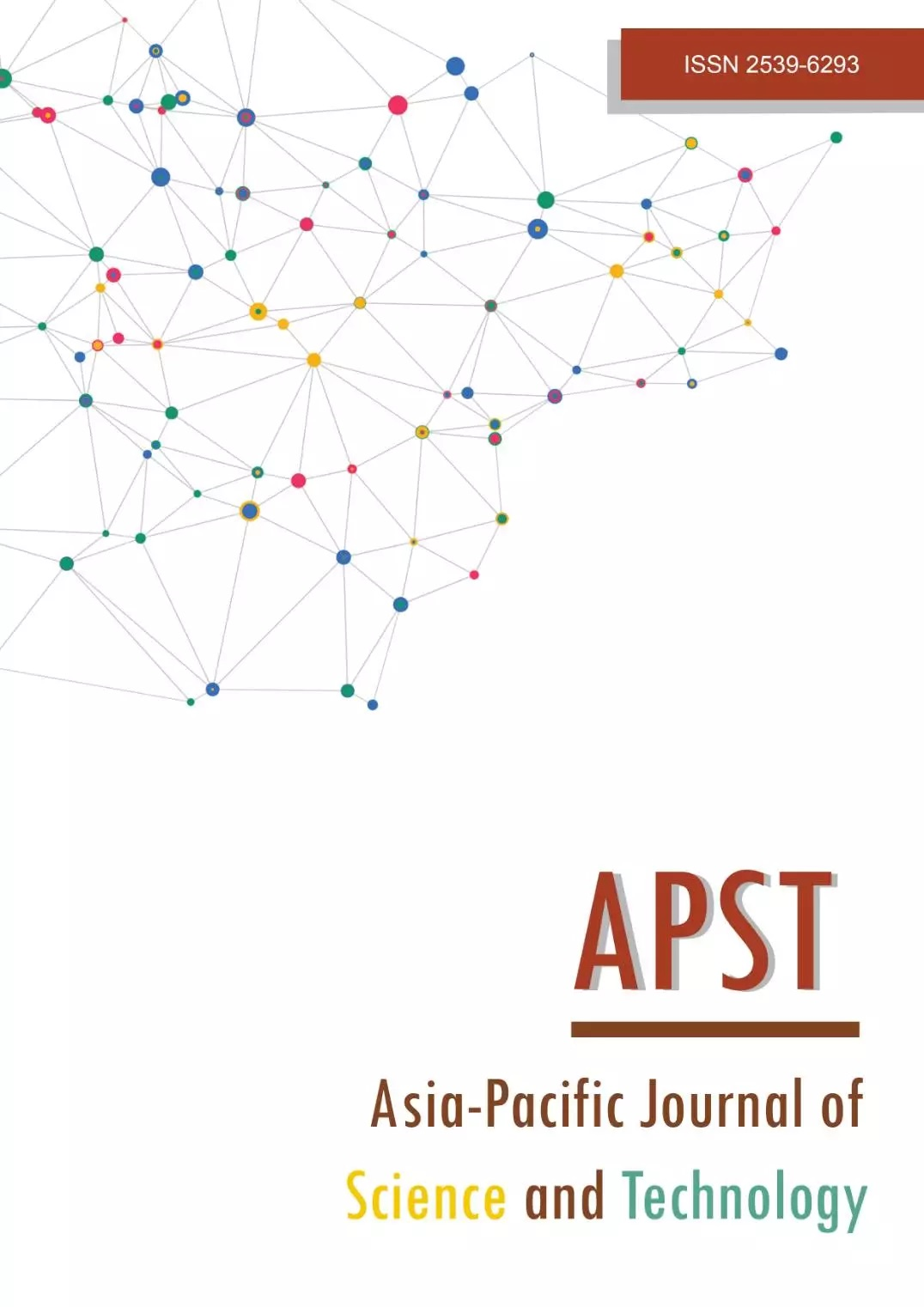Effect of heating time on the nutritional value of sap during traditional brown sugar processing from Arenga pinnata
Main Article Content
Abstract
Investigation of the contents of palm sugar is very important to study the quality of the sugar that comes from Lebak in Banten province, Indonesia. In this study, the nutritional value of the sap was analysed every 30 min during the traditional production of Arenga palm sugar. The content of the simple sugars sucrose, glucose and fructose was analysed during the heating of Arenga sap through application of high performance liquid chromatography. Analysis of the mineral content, i.e. of iron (Fe), zinc (Zn), copper (Cu) and manganese (Mn), was performed through application of atomic absorption spectrometry. The antioxidant activity was determined by application of the ferric reducing antioxidant power assay. The results showed that there was a change in composition of sucrose and fructose in palm sap to sucrose, glucose and fructose in palm sugar. Glucose and fructose content during the production process decreased. However, the sucrose content increased. The highest sucrose content was observed at 90 min of heating, which was 90.35% of all constituent saccharides. Regarding mineral content, Fe was the most abundant, and was found to be present at a level of 132.39 mg/kg at 90 min. The highest antioxidant capacity of 179.99 mg of ascorbic acid/kg sample was observed after 90 min of heating during palm sugar production.
Article Details
References
Terryana RT, Nugroho K, Lestari P. Genetic diversity of sugar palm populations from Cianjur and Banten revealed by simple sequence repeat (SSR) markers. IOP Conf Ser Earth Environ Sci. 2020;418:012038.
Khongsak S, Thongta R. Effects of sugarcane, palm sugar, coconut sugar and sorbitol on starch digestibility and physicochemical properties of wheat based foods. Int Food Res J. 2015;22(3):923-929.
Radam RR, Sari NM, Lusyani L. Chemical compounds of granulated palm sugar made from sap of Nipa palm (Nypa Fruticans Wurmb) growing in three different places. J Wetlands Environ Manag 2014;2(1):108-114.
Ho CW, Aida WMW, Maskat MY, Osman H. Changes in volatile compounds of palm sap (Arenga pinnata) during the heating process for production of palm sugar. Food Chem. 2007;102(4):1156-1162.
Apriyantono A, Aristyani A, Nurhayati Y, Lidya SB, Soekarto ST. Rate of browning reaction during preparation of coconut and palm sugar. Int Congr Ser. 2002;1245:275-278.
Jayanudin J, Kurniawan T, Kustiningsih I. Phenolic analysis and characterization of palm sugar (Arenga Pinnata) produced by the spray dryer. Orient J Chem. 2019;35(1):150-156.
Kurniawan T, Jayanudin J, Kustiningsih I, Firdaus MA. Palm sap sources, characteristics, and utilization in Indonesia. J Food Nutr Res. 2018;6(9):590-596.
Rahman NA, Hasan M, Hussain MA, Jahim J. Determination of glucose and fructose from glucose isomerization process by high performance liquid chromatography with UV detection. Mod Appl Sci. 2009;2(4):151-154.
Mahmood S, Alghamdi MT, Bazaid S, Saleh ES. Determination of fructose, glucose and sucrose in Taif grape using high performance liquid chromatography and analysis of mineral salts. Arch Appl Sci Res. 2011;3(6):488-496.
Sultana P, Dilruba E, Afzal S, Mrityunjoy B, Subed CDS, Golam SJ, et al. Nutritional analysis of date fruits (Phoenix dactylifera L.) in perspective of Bangladesh. Am J Life Sci. 2015;3(4):274-278.
Asghar MT, Yusof YA, Mokhtar MN, Ya'acob ME, Mohd GH, Chang LS, et al. Coconut (Cocos nucifera L.) sap as a potential source of sugar: antioxidant and nutritional properties. Food Sci Nutr. 2019:1-11.
Al TA. Determination of antioxidant activity in different kinds of plants in vivo and in vitro by using diverse technical methods. Nutr Food Sci. 2013;3(1):546-566.
Hebbar KB, Pandiselvam R, Manikantan MR, Arivalagan M, Beegum S, Chowdappa P. Palm sap-quality profiles, fermentation chemistry, and preservation methods. Sugar Tech. 2018;20(6):621-634.
Barclay T, Ginic MM, Cooper P, Petrovsky N. The chemistry and sources of fructose and their effect on its utility and health implications. J Excip Food Chem. 2012;(2):67-82.
Eggleston G, Vercellotti JR. Degradation of sucrose, glucose and fructose in concentrated aqueous solutions under constant pH conditions at elevated temperature. J Carbohydr Chem. 2000;19(9):1305-1318.
Asif HM, Akram M, Saeed T, Ibrahim MK, Akhtar N, Ur RR, et al. Carbohydrates. Int Res J Biochem Bioinforma. 2011;1(1):1-5.
Almeida AC, Araújo LC, Costa AM, Abreu C, Andrade MAGA, Fernandez MP. Sucrose hydrolysis catalyzed by auto-immobilized invertase into intact cells of Cladosporium cladosporioides. Electron J Biotechnol. 2005;8(1):54-62.
Shipar AH. A general review on maillard reactions in foods. 2009:3-13
Nie S, Huang J, Hu J, Zhang Y, Wang S, Li C, et al. Effect of pH, temperature and heating time on the formation of furan in sugar-glycine model systems. Food Sci Hum Wellness. 2013;2(2):87-92.
Reyes FGR, Poocharoen B, Wrolstad RE. Maillard browning reaction of sugar-glycine model systems: changes in sugar concentration, color and appearance. J Food Sci. 1982;47(4):1376-1377.
Luchini P, Bernardi M, Borges M, Bettani S. Mineral and metal levels in brown sugar from organic and conventional production systems. J Agric Sci. 2017;9(10):226-233.
Janah YN, Sulaiman A, Yusuf NA, Ghazali DR. Sugars, minerals composition and metal ion chelating activity of Arenga pinnata syrup using vacuum evaporation. Malaysian J Anal Sci. 2018;22(2):264-269.
Winarni S, Arifan F, Wisanu BRTD, Fuadi A, Alviche L. Nira acidity and antioxidant activity of palm sugar in Sumowono village. J Phys Conf Ser. 2018;1025:1-4.


